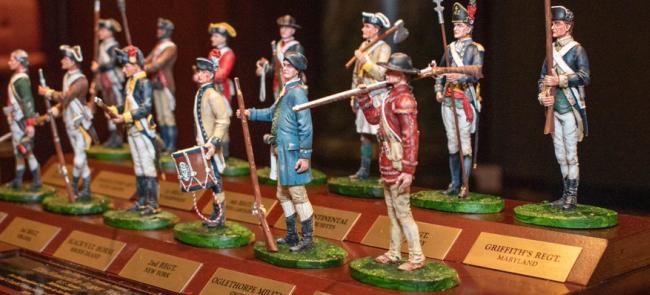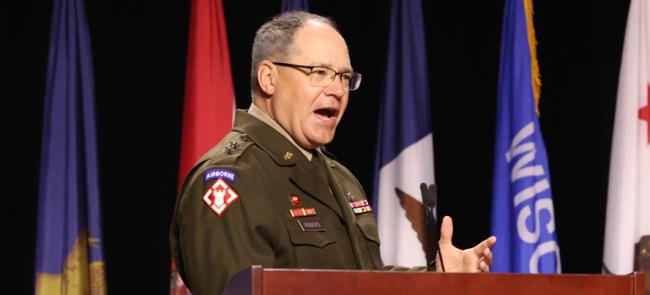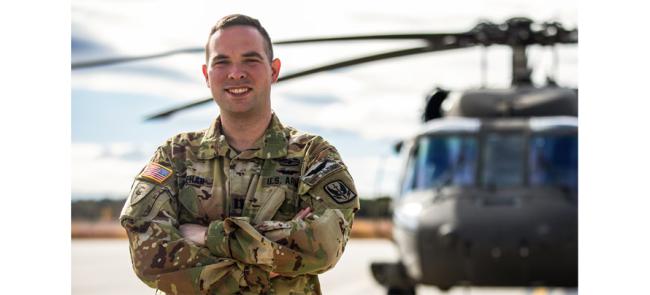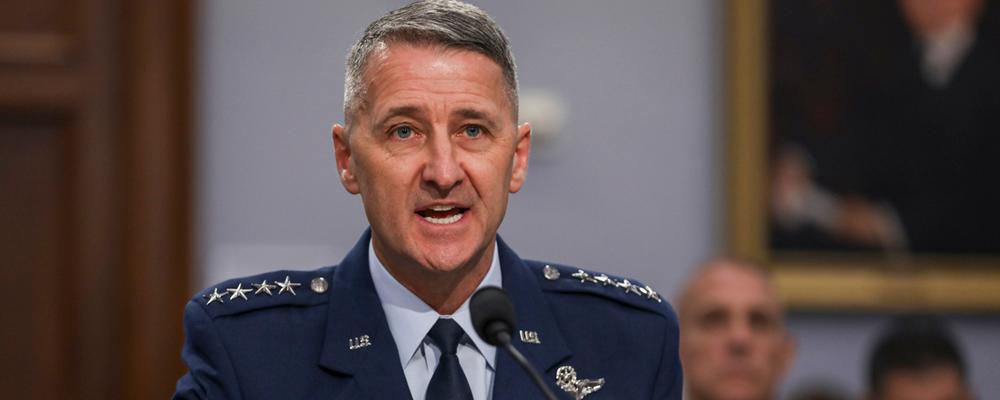
A Conversation with Gen. Steven S. Nordhaus
30th National Guard Bureau Chief
Gen. Steven S. Nordhaus is an optimist. It’s part of his nature. It’s also a product of his upbringing.
Nordhaus says he takes after his first mentor, his father, who spent time in the Navy. “He taught me that problems are just opportunities to overcome and succeed, to work hard and to have fun every day,” he says. Today, he believes optimism can be a “force multiplier.”
That’s the approach the 30th chief of the National Guard Bureau takes in his role as the Guard’s voice on the Joint Chiefs of Staff. He also testifies regularly on Capitol Hill.
He uses one word to describe the Guard’s current contributions at home and abroad: “Amazing.”
“We provide 20% of the total Joint Force for less than 4% of the DoD budget,” he says. That includes 40% of the Army’s operational combat forces and 30% of the Air Force’s combat forces. “We create incredible dilemmas for our adversaries,” Nordhaus adds.
Of course, there are challenges. Access to health care to ensure readiness, incentive and special pay parity, and modernization are among those, he says.
Nordhaus sat down with NATIONAL GUARD in July to talk about his priorities, his approach and the way forward for the Guard.
New leaders typically enter a position with a few priorities. What are yours?
Our North Star is certainly peace through strength, as the president said, and to achieve that, we’re following the secretary of defense’s priorities and his focus areas to ensure success across our mission sets of the homeland, the warfight and overseas partnerships.
We will remain focused on recruiting and retaining the best talent for our warfighters and taking care of our families. So, No. 1 is making sure our warfighters are ready, trained and capable of doing the mission sets when called upon. And we’ll prioritize building readiness, individually and collectively, strengthening partnerships local and global, and to share burdens, not only here but across the globe. And then to modernize our equipment, our tactics and our processes to create debilitating dilemmas for our adversaries to deter and win if deterrence fails. So, what I like to talk about here is we’re focused on our warfighters and families, and then RPM right readiness, partnerships and modernization. And every day, we’re trying to make each one of those a little bit better.
As a member of the Joint Chiefs of Staff, you meet regularly with the JCS Chairman, Air Force Gen. Dan Caine, a career Air National Guard officer. You also interact with Defense Secretary Pete Hegseth, who rose to the rank of major in the Army National Guard. What’s it like advising leaders who’ve literally lived the Guard?
Thanks for that terrific question. And it’s great to serve our nation, the 54 adjutants general and our Guardsmen, especially during a time when the secretary of defense and the chairman have also served in the National Guard and have combat experience. They understand our citizen-Soldiers and Airmen and how they bring incredible experience and innovation to every mission set. An MP company might be one MOS, but it brings 40-plus civilian skill sets to every mission, whether it’s cyber that they do in their civilian skill set, electrician, police officer, logistics and all those capabilities. They bring together this great, incredible force of experience that’s very cost-effective. At the end of the day, the National Guard is a huge part of the Joint Force, and we’re ready, experienced and accessible to serve our nation. And it’s great to serve underneath the secretary of defense and with the chairman.
Your role as a channel of communications between the Pentagon and the states also has you regularly speaking to the adjutants general. What have they been telling you lately?
First off, I’m humbled to serve as a channel of communication between the 54 states, territories and the District of Columbia and the Army, the Air Force and the Department of Defense. I have weekly calls with the adjutants general, and I’m always impressed at how they’re leading with distinction, and they’re building readiness partnerships and modernization across the force. They are crushing recruiting and retention goals right now, both on the Air and the Army National Guard side. On the Army National Guard, we’re at 328,000 strong, and on the Air National Guard side, we’ve continued to have historic levels every month, and we’ll be at over 105,000 at the end of the year, reaching our goal there.
I also try to have daily one-on-one conversations with at least one TAG a day. So, I’m constantly getting input from the TAGs on a daily basis, understanding the challenges in their state, territory or the District of Columbia and what’s really driving their focus for the day, so I can make sure I stay on message and understand their needs, and to also ensure there are no gaps or seams. And then I’ll call them directly if I see something happening in the news, or they might call me directly to let me know that something’s happening, whether it’s a hurricane, a wildfire or flood, or if they’re calling out Guardsmen in support of a mission set from their governor.
These calls come in 24/7 don’t they?
They can. They can.
We're in the business of credible deterrence.
The nation seems to be under increasing threats in multiple domains. As you look across the nation and around the world, what threats and which domains concern you most?
We’re in the business of credible deterrence, peace through strength. With 40% of the Army’s operational combat forces and 30% of the Air Force’s combat forces, we create incredible dilemmas for our adversaries. Our operational capability with strategic depth continues to help counter those threats that are out there that we see on the news around the globe. However, we must concurrently modernize our forces at pace and speed with our active-duty counterparts in the Air Force and the Army, so we are always ready and always there. We must also continue to advance our capabilities in cyber and UAS and counter UAS to stay ahead of changes in the character of war that we see in such places like Russia and Ukraine.
What is your guidance to National Guard officers across the country on the threats across all these domains?
I would like to add senior enlisted leaders as well, because they make up such a large part of our force. So, we have to be one team there, and we need to lead with distinction. We need to work hard, we need to continuously learn and we need to follow that humble, approachable, credible motto there to make sure that our Airmen and our Soldiers want to come to us so that we can solve their problems.
I use my standard operating procedure, what I call my SOP, which is service, optimism and passion to lead. When I do that, there’s no limit to the good that we can do when we’re serving each other. The O is for optimism, and that’s a force multiplier. When I see how we look at problem sets, let’s figure out if there’s a problem, and when we optimistically look at it, we know that as the National Guard we can solve it together with our Joint Force, with our allies and partners, wherever that might be. The P is for passion. It’s that good energy to keep pushing forward through challenges, to accomplish great things for our National Guard and for our nation.
The administration, the new administration, has talked a lot about Golden Dome. What could that mean for the Guard?
I look forward to working with Gen. [Michael] Guetlein [the Space Force general who heads the Office of Golden Dome for America] to solve and establish America’s Golden Dome. The National Guard already plays a large role in ballistic missile defense. We have all the air defense sectors for our nation across not only the continental U.S., but also up in Alaska and out in Hawaii, we have fighters and tankers that do the mission set across our nation and we defend the NCR [National Capital Region]. The National Guard is very excited to partner and work out and work towards new opportunities to play an even larger role in defending and securing our homeland through Golden Dome.
The character of war appears to be changing fast, which has all the services looking for more resources to modernize? Are the services considering the Guard’s value-proposition as a possible solution?
At 433,000 strong and 20% of the Joint Force, we’re a large part of the combat capability for our nation. And we serve both the state and the nation. The National Guard is dynamic and a terrific force that offers operational capability with strategic depth. It supports this resilient homeland, which deters our adversaries as well, and we’re partnered with over 60% of the nations on the globe, which is really incredible. The National Guard will continue to provide our services with solution options that increase combat capability, domestic response, with cost effective and experienced forces that defend the homeland, deter adversaries, and partner local to global in sharing, burden sharing for our nation.
Resiliency in the homeland not only keeps our citizens safe, it deters our adversaries.
Governors and now the president are increasingly calling on the National Guard to conduct domestic missions. We are now in hurricane and wildfire season, which will likely increase demand for the Guard. What impact does all this have on the National Guard’s primary peacetime task — training for war?
The National Guard is known for answering our nation’s call, right? Whether it’s floods in Florida or Texas, whether it’s hurricanes that impact the East Coast or southern states, whether it’s up in Alaska, rescuing, saving lives or supporting the combatant commands. We are manned, trained and equipped to support both the federal and the state mission. All the [domestic] missions also benefit individual and platoon-level training and readiness for building cohesive teams, solving problems and finding creative ways to ensure mission success.
I’ve talked about the 433,000 strong, but day to day we roughly have, on average, about 40,000 folks deployed in the United States or overseas, and so that’s about 10% of the force. The rest of the force is able to train and get ready for the warfight or additional responses to defend and secure our homeland. All these things also help us build relations with our state and local officials. And again, resiliency in the homeland not only keeps our citizens safe, it deters our adversaries, making us stronger together and stronger tomorrow.
The Army is embarking on a major restructuring that figures to significantly affect the Army National Guard combat force structure. What do Army National Guard officers need to know about the Army Transformation Initiative?
Transforming our Army National Guard is critical to gaining the agility, the speed, the lethality required to deter and win in future conflicts, if we are needed. At 40% of the operational Army, we will transform, as General [Randy A.] George [the Army chief of staff] said, at the same pace and speed as the active force. We all see the changing characteristics in warfare, and we are transforming and infusing technology and new equipment to win on the battlefield and to defend our homeland and better respond to crises that might happen across the 54 states, territories and our District of Columbia.
We must concurrently modernize our forces at pace and speed with our active-duty counterparts.
Fighter recapitalization is a major issue in the Air National Guard. The Air Guard has 25 fighter units. All of them appear to be critical to air sovereignty at home and any potential overseas war fight. Yet many Air Guard units with older aircraft are not in the Air Force’s fielding plans for modern fighters. Air Guard fighter units have some of the most experienced fighter pilots and maintainers in the Air Force. Why is the Air Force not making more of an effort to retain this talent?
As we look at modernization across the Air National Guard and the Army National Guard, we must do it concurrently. We must make sure that our Soldiers and Airmen, because they’re 40% of the Army’s operational force and 30% of the Air Force’s combat forces, are in ready and capable equipment that can be interoperable and ready to go fight for our nation and defend the homeland. Back in the United States, as I talked about, we are a significant portion of our nation’s homeland defense. You could also see, as we spun up for Operation Rough Rider and we supported Operation Midnight Hammer, that the National Guard played a large part in each one of those things, whether it was bombers or fighters or tankers, mission planning cells, air operation centers, intel. The National Guard brings that additional experience and additional skill set to help the Total Force accomplish those mission sets. So, we look forward to working and continuing to work with both the Air Force and the Army on modernizing our equipment and our capabilities across the force.
You mentioned Midnight Hammer, the air attack on Iranian nuclear facilities. Gen. Dan Caine, the chairman of the Joint Chiefs of Staff, made sure to tell those in a press conference that the Missouri Air National Guard’s 131st Bomb Wing, which is a classic associate to the active-component’s 509th Bomb Wing, played a major part in the operation. Did that surprise people in the Pentagon?
I can’t speak for whether it surprised some people, but I can tell you that it didn’t surprise me. I know how ingrained our folks are across our units and our associations, and that’s what makes our nation so strong, and our Air Force and our Army so strong. These associations where we work together hand in hand, shoulder to shoulder to make sure that we can accomplish a mission set as effectively and with the experience and the capabilities that the National Guard brings to the force.
The fiscal 2022 National Defense Authorization Act gave the Pentagon until September 2022 to provide Congress with an implementation plan for incentive and special pay parity. Currently, members of the National Guard and Reserve receive far less in incentive pay to maintain the same proficiency of those in the active component. It’s been almost three years and Congress has still not received that implementation plan. What’s going on?
Taking care of our warfighters, like I talked about, is priority No. 1 for me, and so we’re working with the [Defense] Department. Bonus parity is critical to our National Guardsmen who are meeting the same training and proficiency standards as their active-duty counterparts. I can tell you the Department is reviewing a recent study. Right now, our National Guard team is working on multiple mission-planning cells and working closely with the Department to support future senior-leader decisions on an implementation plan, and we’re hoping sooner rather than later.
Health care is a strategic investment in our warfighters and our families.
A top NGAUS priority is zero-cost TRICARE health coverage for every member of the National Guard. As you know the National Guard Bureau estimates that nearly one in five Guard Soldiers and Airmen have no medical coverage. Providing no-cost health coverage would increase medical readiness. It also could bolster retention. What’s your take?
Once again, back to warfighters. We got to take care of them and their families, and health care is a strategic investment in our warfighters and our families and ensures we have ready Soldiers and Airmen when called upon. It adds another key layer to our deterrence for our Department of Defense. We continue to advocate for policies to increase access to health care and to decrease costs for our Guardsmen. Regarding providers, we’ve made progress, but gaps remain, particularly in rural areas and for specialized access. Health care will remain one of my top priorities for our warfighters and families. And I do see progress being made. We just need to stay after it.
The Space Force has said it will take overall space missions currently performed by the Air National Guard on Oct. 1. Space Force officials say they’re just following the law, but the fiscal 2025 National Defense Authorization Act gave the Space Force eight years to make the transfers. This also appears to be in conflict with the president’s intent. Why is this happening and what’s the rush?
For nearly three decades, the Air National Guard has provided incredible space capabilities for our Joint Force. Our civilian leaders have made decisions and we will execute those to the best of our ability, while taking care of the mission and our warfighters. We are quickly working new missions in line with the National Defense Strategy and our priorities to support the Air Force and our service members as we go into the future.
So, the units and personnel affected will find themselves in new missions in the future?
Absolutely. Any Airman who doesn’t transfer to the Space Force, we’re focused on re-missioning with the secretary of the Air Force to put them in new mission sets that are in line with the NDS and help make our Air Force and our Air National Guard strong.
You’ve probably had several mentors over the course of your career. What is the best leadership advice you’ve ever gotten? And do you still use it on a day-to-day basis?
I’m going to go back to my best mentor, my dad, who spent a couple years in the Navy. He taught me that problems are just opportunities to overcome and succeed, to work hard and to have fun every day. So, I really get my service, optimism and passion, my SOP from that, and it gets after learning those lessons to serve, be optimistic as I problem-solve and to have a passion every day to get up, tie my boots and get after solving problems for not only the National Guard, but for our Guardsmen who are across 2,500 communities doing incredible things within their states, territories and the District of Columbia, but they’re also doing mission sets across the globe to help defend our nation and secure our allies and partners.
TOP PHOTO: Nordhaus joins other reserve chiefs to testify during a House Appropriations Defense Subcommittee hearing in Washington, D.C., May 20. (MASTER SGT. ZACH SHEELY)
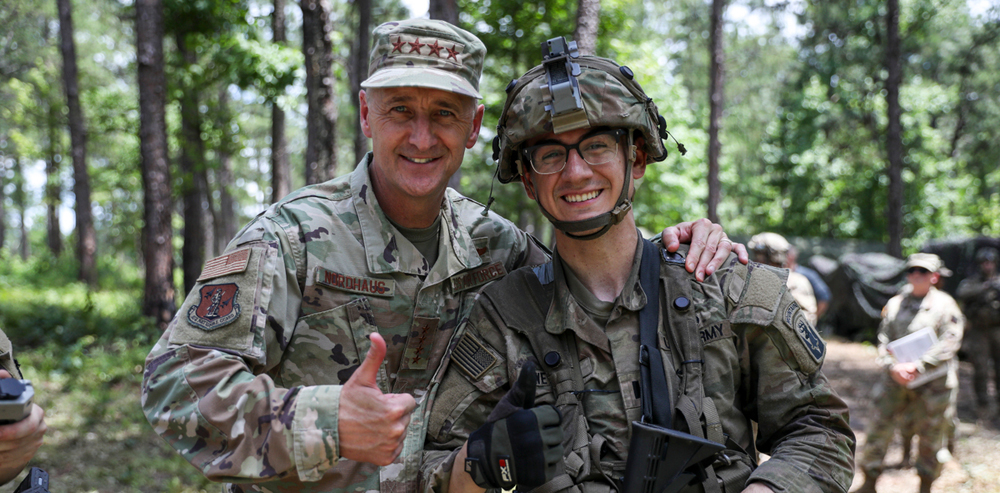
AT A GLANCE: Gen. Steven S. Nordhaus
BORN: Steven S. Nordhaus, Oct. 13, 1966 (Putnam County, Ohio)
FAMILY: Wife (Shannon), five children and six grandchildren
EDUCATION: U.S. Air Force Academy, Colorado Springs, Colo, B.S. Engineering; Columbia Southern University, Orange Beach, Ala., M.S. Organizational Leadership, 2013
COMMISSIONING SOURCE: U.S. Air Force Academy
MILITARY SERVICE: Active-component Air Force 1989-1998; Ohio Air National Guard 1998-present
PREVIOUS ASSIGNMENTS: Commander, 1st Air Force, Tyndall Air Force Base, Fla., 2023-2024; Special Assistant to the Director of the Air National Guard, Arlington, Va., 2022-2023; Director of Operations, National Guard Bureau J-3/4/7, Arlington, Va., 2019-2022; Commander, Air National Guard Readiness Center, Joint Base Andrews, Md., 2017-2019; Deputy Director of Operations, North American Aerospace Defense Command, Peterson Air Force Base, Colo., 2015-2017; Executive Assistant to Chief of the National Guard Bureau, Arlington, Va., 2013-2015; Commander, 180th Fighter Wing, Toledo, Ohio, 2011-2013
OVERSEAS OPERATIONS: He has flown 83 combat missions in operations Southern Watch, Vigilant Warrior, Northern Watch, Iraqi Freedom and Enduring Freedom
ALSO NOTABLE: Has more than 3,000 flight hours in the T-37, T-38, F-16A, F-16C/D Block 30/40/42/50/52 and F-35A. He was promoted to the rank of general Oct. 2, 2024. He officially became the 30th NGB chief in a ceremony Oct. 15, 2024.
Source: National Guard Bureau

